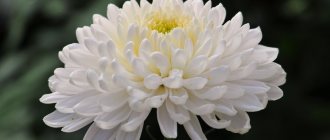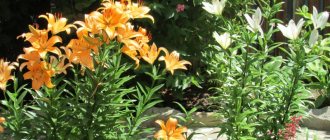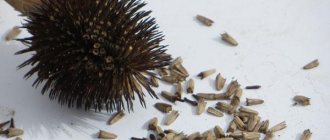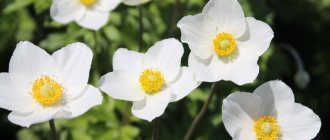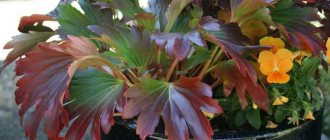Chrysanthemum is unconditionally recognized as one of the most favorite flowers among gardeners and florists. As a rule, nurseries sell cuttings of this plant, since most of the “queen” varieties of autumn gardens and bouquets are hybrids, the propagation of which by seeds is a complex and unpredictable process. However, the technology of growing chrysanthemums from seeds, planting and caring for them in open ground conditions remains relevant and is used by many gardeners even in the climatic conditions of the middle zone.
Chrysanthemum is one of the leading cut crops, occupying the second position after the rose; its production and sales volume is approximately 3 times inferior to the “queen of flowers”.
Chrysanthemums from seeds: growing features
Initially, when chrysanthemums were not yet so diverse, but were annuals resembling daisies with yellow petals, which reproduce well even by self-sowing, they tried to grow them from seeds. Today, this culture has thousands of varieties, most of them are hybrids, which, when grown from seeds, lose many of their distinctive features. But, if you like surprises, and getting a flower of a strictly defined color, shape and size is not important to you, try growing chrysanthemums from hybrid seeds. Their germination rate is high, and as a result you can get flowers with a wide variety of amazing shapes and colors.
When starting a conversation about whether it is possible and how to properly grow chrysanthemums from seeds, you need to understand that small-flowered Korean and some annual varieties are mainly propagated in this way. Most often, kits for growing chrysanthemums from seeds from China can be found on sale as planting material. At the same time, perennials, as a rule, are first grown as seedlings, and annual chrysanthemums can be propagated through seedlings and sowing seeds directly outside.
Photos of annual chrysanthemums
The photo below shows various ways to use annual chrysanthemums in garden design:
Mostly annual chrysanthemums are used as a filler for mixborders
Low-growing varieties (for example, Kamina Red) when planted densely act as cover plants
Annual chrysanthemums are often grown in pots and flowerpots
In flower beds, these plants predominantly fill areas of medium and low level
Annual cut chrysanthemums can be obtained in pots at almost any time of the year.
How to get chrysanthemum seeds
Chrysanthemum seeds
Seeds of various varieties of chrysanthemums are always on sale, but after growing this flower once you can collect them yourself. When growing indoor or garden chrysanthemum for seeds, you need to consider the following points:
- Large-flowered and double varieties produce very little seed material, and it is difficult to grow them from seeds.
- Small-flowered simple and semi-double chrysanthemums produce a sufficient number of seeds with good germination.
- It is easiest to collect high-quality seeds from early and mid-early varieties; in late-flowering varieties they simply do not have time to ripen.
In order to get high-quality seeds from a plant with good germination, you need:
- plant seedlings in open ground as early as possible;
- regularly water, feed and plant;
- make sure that small-flowered chrysanthemums have no more than 5-8 stems, and large-flowered chrysanthemums have no more than 3 stems;
- leave only one bud on one stem.
For chrysanthemums that bloom in mid-summer, the seeds are collected while they are still in the garden. For plants that bloom until late autumn, proceed as follows:
- to protect the flowers from getting wet, if it is not possible to transfer them to the greenhouse, the bushes are covered with film;
- before frost, the plants are transplanted into pots, transferred into the house and placed on a windowsill located on the sunny side;
- if a chrysanthemum has to be grown in a greenhouse, it is covered with film so that the receptacle is not damaged by condensation.
The seeds are collected in November-December, as soon as the inflorescences turn brown. If this moment is missed, they will crumble.
The seeds are removed when the baskets begin to dry out. They are then ripened indoors. Interestingly, immediately after collection, seed germination is only 10%, and only after 2 months of storage do the seeds acquire optimal germination.
How to protect against pests and diseases
As a rule, chrysanthemums are not susceptible to diseases. There are cases when a plant is affected by spider mites, but you can easily get rid of it with a soap solution or use the Petherium solution.
If the chrysanthemum suffers from powdery mildew or gray mold, then the flower must be treated with fungicides “Skor” (consumption rate: 2 ml of the drug per 10 liters of water) or “Topaz” (4 ml per 10 liters of water). Consumption is 1 liter of solution per 10 sq.m.
Their bitter, wormwood smell evokes slight sadness and thoughts of the approaching cold. And if you want to please your loved ones, then give them cut chrysanthemums, on which an admiring glance will dwell for a long time. An equally luxurious gift is potted chrysanthemums. One of the most accessible varieties is the Korean chrysanthemum.
Growing chrysanthemum seedlings from seeds
Sowing chrysanthemum seeds for seedlings
Sowing seeds for growing seedlings is carried out in early spring in moist soil collected equally from peat, humus and greenhouse soil. Ready-made seed mixture can be purchased at a specialty store, and as a rule, it is already ready for use, or you can make it yourself. In this case, before sowing chrysanthemums, it must be sterilized with a weak solution of potassium permanganate and then dried (the potassium permanganate solution is prepared by eye: the water in this case takes on a pale pink color). And then you still need to disinfect the soil mixture itself. To sterilize, the substrate is sifted and calcined in the oven for 15-20 minutes at a temperature of 120-130 degrees.
To sow chrysanthemums with seeds and grow seedlings, you will need a shallow box. A drainage layer of expanded clay or brick chips is placed on its bottom. The prepared soil is poured on top, it is leveled and the seeds are laid out on its surface, pressing them lightly. There is no need to sprinkle them with soil: for the sprouts to hatch, they need light.
Then the soil in the box is sprayed from a spray bottle with pre-prepared, settled water at room temperature and covered with glass or transparent film. Before seedlings emerge, the room temperature must be maintained within +23-+25 degrees. The covering is removed from time to time to ventilate the seedlings, condensation is removed from it, and the substrate is regularly sprayed to prevent drying out.
Seedling care
Chrysanthemum seedlings grown from seeds
When growing chrysanthemums from seeds at home, the seedlings hatch within 12-14 days. With their appearance, the box is moved to the sunniest place in the room. In order for the crops to become accustomed to the air temperature in the room, the covering is now removed daily, with a gradual increase in the duration of the ventilation sessions. After about 7-8 days, the coating is completely removed.
Chrysanthemums grow very quickly. In a short period of time, a small, inconspicuous cutting produces a fairly powerful bush, which manages to bloom profusely and finish its growing season in the fall. Therefore, chrysanthemums need frequent feeding, at least three times during the summer.
When 2-3 true leaves form on chrysanthemum seedlings, they are planted in cups prepared in advance for seedlings, or small pots in the same pre-sterilized and well-moistened substrate as in the box. Before starting the dive, the soil in the box also needs to be watered. Seedlings are planted carefully, without damaging the delicate and fragile roots. Poorly developing, sluggish, weak shoots are discarded. Sprouts planted in cups are sprayed with a solution of some biogrowth stimulator. After picking, the temperature in the room must be maintained at 16-18 degrees.
If there is not enough daylight in the room, install additional lighting above the boxes with chrysanthemum seeds at a height of 20-25 cm using a phytolamp, LED or gel lamp, but not an ordinary incandescent lamp. In the future, caring for seeds for seedlings consists of regular watering and fertilizing with a solution of some complex mineral fertilizer, carried out once every two weeks. After about a month and a half, young chrysanthemums will grow to 20-25 cm, and they can already be transplanted outside.
Description of the plant
Chrysanthemum is loved by many gardeners not only for its beautiful flowering, but also because it is one of the last to begin to bloom and until the very cold weather pleases the eye with its chic appearance. This flower is found naturally in China, North America, Asia and Europe . Chrysanthemum has many varieties, numbering about 150 pieces.
This flower is grown both at home and in a summer cottage. In the latter case, only two varieties are used:
- Korean;
- ground chrysanthemum.
It belongs to the Asteraceae family. It begins to bloom in September and ends a month later, in October. The height of the shrub ranges from 30 to 110 cm . The higher it is, the more flowers are formed on it, and under favorable conditions, up to 100 inflorescences with a double or semi-double surface can appear. The branched roots of the plant can penetrate the soil to a depth of 20 cm.
The following types of chrysanthemums are most often purchased for cultivation in personal plots:
- Alpine;
- Crowned;
- Keeled;
- Shrub;
- Chinese;
- Korean.
Hybrid varieties tolerate temperature changes and bad weather much more easily. They are less likely to be affected by pests and various diseases, and they have a long flowering period.
Planting seedlings in open ground
Three-week chrysanthemum seedling
It is very important to correctly calculate the time when to plant chrysanthemums outside. This is done as soon as the spring frosts pass and stable warm weather reigns. This usually happens in the last days of May. In this case, chrysanthemums begin to bloom at the end of June. In open ground, chrysanthemums are sown with seeds, without seedlings, in mid-May, placing them in depressions made every 25 cm, 3-4 pieces each. With this approach, the buds will begin to bloom in the first half of August. If all the seeds sprout in one hole, leave the strongest sprout and plant the rest.
The predecessors of chrysanthemums on the site can be herbs, legumes and ornamental annuals. Chrysanthemums should not be planted in places where tomatoes and potatoes previously grew.
8-10 days before planting the plants in open ground, they begin to accustom them to the street, taking them out to the balcony or garden every day, gradually increasing the “walk” time. By the time of landing, they should calmly spend a full day in the open air 2-3 times in a row.
In the future, the methods for growing chrysanthemums from seeds and from cuttings are similar. A rainy or cloudy day is best for planting. Chrysanthemums love light, warmth and do not tolerate stagnation of moisture at the roots. The site for them is chosen on a small hill (for water drainage), illuminated by bright sun for at least 5 hours a day. It’s great if some vegetables were grown in this place in the previous season, but if the predecessors were flower crops, it’s better to choose another area.
Small-flowered chrysanthemum multiflora
The soil for planting chrysanthemums needs to be nutritious, neutral or slightly acidic, ideally loamy. If the soil is clayey or sandy, it is improved by digging it up before planting the seedlings along with organic fertilizers and mineral complexes, such as vermicompost and humus. Fresh manure cannot be used. There should not be too much fertilizer; it must be distributed sparingly and evenly, otherwise, due to its excess, the chrysanthemum will grow an abundant green mass and bloom sparingly.
A shallow trench is dug for the seedlings. Seedlings are placed every 30-50 cm: the larger the variety, the more space it needs. The planted plants are carefully watered at the root with Kornevin's solution (1 g of fertilizer per 1 liter of water). This will help speed up their growth. To create the necessary conditions for adaptation, the bed with seedlings is covered with lutrasil and spunbond. When the plants begin to grow, the covering is removed.
Types and varieties of chrysanthemums
With a huge number of chrysanthemum cultivars, unfortunately, there is still no unified classification of varieties and hybrids of this plant. Different countries use different systems. Varieties are divided according to the size of the inflorescences and the height of the bush, according to the shape of the inflorescence, and according to the timing of flowering. There is also a division into perennial and annual chrysanthemums.
Annual chrysanthemums include the following types:
- tricolor or keeled chrysanthemum (varieties Nordstern, Cocarde and Flammenstahl);
- field or sowing chrysanthemum (varieties Helios, Stern des Orients);
- crown chrysanthemum (Tetra Comet variety).
Annual chrysanthemums are also known in cultivation: multi-stemmed, or Minok, daisy, maiden, marsh, and also prominent, or rotated.
Other species, garden forms, varieties and hybrids can be grown in perennial culture.
According to the timing of flowering, chrysanthemum cultivars are divided into:
- early (Deliana, Zembla Yellow, Handsam);
- medium flowering (Froggy, Anastasia Lil, Orange);
- late (Rivardi, Larisa, Avignon).
Simple chrysanthemums differ in the shape of their inflorescences:
- non-double (Pat Jois, Ben Dixon);
- semi-double (Baltika, Amazon, Natasha);
- anemone-shaped (Andre Rose, Vivienne, Beautyful Lady)
and terry:
- chrysanthemum globulus (Kremist, Broadway, Arctic);
- hemispherical chrysanthemum (Trezor, Gazella, Zlata Prague);
- chrysanthemum reflexum (Tracy Waller, Regalia);
- chrysanthemum flat (Valli Ruf, Swan song);
- pompom chrysanthemum (Fairy, Bob, Denis);
- chrysanthemum radiata (Tokyo, Pietro, Magdalena);
- spider chrysanthemum (Grace, Spring dawn on the Su-Ti dam).
Depending on the size of the flower, chrysanthemums are classified as large-flowered, medium-flowered and small-flowered.
Chrysanthemum grandiflora reaches a height of 120 cm, and the diameter of its inflorescences, which have different shapes, can be from 10 to 25 cm. These varieties are grown mainly for cutting. Large-flowered chrysanthemums do not have a high level of winter hardiness, but recently cultivars have appeared that can winter normally in open ground. Varieties:
- Anastasia Green - green chrysanthemums on a bush with a height of 80 to 120 cm;
- Zembla Lilac - a variety with large double inflorescences with wide reed flowers on a bush up to 90 cm high;
- Tom Pierce is a bush up to one and a half meters high with red spherical inflorescences with a diameter of 22 cm. The reverse side of the reed flowers is orange.
The medium-flowered chrysanthemum, which is usually called decorative, reaches a height of no more than a meter. Its inflorescences are 10-18 cm in diameter. It is used not only for cutting, but also for decorating borders, balconies and terraces. Varieties:
- Pink chamomile is a chrysanthemum with a height of 60 to 90 cm with dark pink inflorescences with a diameter of 6-8 cm;
- Splash of champagne - a bush up to 90 cm high with needle-shaped pale pink baskets and a yellow coating in the center. There is a variety with golden inflorescences;
- Golden Fleece - yellow chrysanthemums with an orange tint on a bush up to 60 cm high.
Small-flowered chrysanthemum, or Korean chrysanthemum, is a species of frost-resistant plants that are simply called “oak trees” for the shape of their leaves, reminiscent of oak leaves. The height of the bushes of these chrysanthemums reaches from 25 to 120 cm. They form numerous inflorescences with a diameter of 2 to 10 cm, simple and double, painted in all sorts of colors. Varieties:
- Snow White - double white chrysanthemums with a diameter of 6-7 cm on a compact bush up to 70 cm high;
- Amber - on small bushes with a height and diameter of about 50 cm, terry bright yellow baskets with a diameter of up to 7.5 cm are formed;
- chrysanthemum Multiflora is a series of early varieties of new selection with spherical inflorescences of a wide range of colors.
Caring for chrysanthemums in the garden
Korean chrysanthemum "Okishore" grown from seeds
Chrysanthemum is a non-capricious plant. Caring for it is not difficult, but it requires compliance with some rules that it is advisable to learn before growing chrysanthemums from seeds:
- In the same area without replanting, chrysanthemums grow successfully for 2–3 years. In the first 3-4 weeks, the soil must be loosened frequently; during this period of time, the root system is actively growing, and, more importantly, underground shoots are developing, which will subsequently form the entire bush. After a month, loosening is stopped, as it can harm the growing young shoots.
- Chrysanthemums are drought-resistant, but during initial growth they constantly need moisture. During this period, they are watered frequently and abundantly, at least three times a week. When the buds are set and the chrysanthemum is blooming, you can use the “dry watering” method: loosen the soil superficially, to a shallow depth, periodically hilling up and unhilling the bushes. This method is especially useful and effective in rainy or humid weather.
- Chrysanthemums grow better if the soil around them is mulched. A layer of mulch prevents pathogens of fungal diseases that multiply in the soil from moving onto the bush with water splashes during watering and during rain. Pine needles are best suited for mulching; they not only protect the plant from pests, but also do not allow weeds to grow. You can also use oat straw or pine bark as mulch.
With irregular watering, the stems of chrysanthemums become woody, and the quality of the flowers deteriorates. Water especially abundantly in dry, sunny weather, and during the period of shoot growth. During budding, watering is reduced.
To make the bush thicker, at the stage of the eighth true leaf, the plants are pinched. If desired, cut shoots can be rooted and planted at home in a pot or in open ground in the fall, in early September. Large-flowered plants, from which all side shoots are removed, with the exception of a few of the strongest and strongest, do not need pinching, but they are usually propagated vegetatively and not by seeds at home. Tall varieties often need to be tied to a support. It can be made from a tall wooden peg, a metal rod or a metal mesh attached around the bush in the form of a cylinder.
Yellow small-flowered chrysanthemums
As for wintering, as we said above, seeds are propagated mainly by small-flowered Korean varieties, which are perfectly adapted to the climate of central Russia. In order for them to survive the winter, they are hilled up, covered with boxes and topped with some kind of covering material.
All articles about chrysanthemums on the site can be read by following this link...
But you need to keep in mind: perennial chrysanthemums growing on a dry hill will not freeze, but those growing in lowlands where moisture accumulates will freeze. To prevent this from happening, the bushes are pruned, cutting the stems to 15-20 cm, placed in boxes with soil and taken to the basement for winter storage.
Description
For almost every person born during the Soviet era, this plant brings back childhood memories. After all, the first thing we saw at my grandparents’ dacha or in the village was the annual chrysanthemum. Photos of this flower are presented in this article. This culture is relatively undemanding to growing conditions. Chrysanthemum rhizomes are branched, they develop parallel to the surface. The shoots are either bare or pubescent.
The annual chrysanthemum has leaves arranged alternately. They are simple, but different in shape and size. The plant may have notched or jagged, dissected leaves, or may even not be present at all. The color of the greens is usually light, although in some varieties it can be dark. Small chrysanthemum flowers are collected in a basket. Sometimes it can be quite large. The fruits of chrysanthemums are achenes.
This plant begins to bloom somewhere in mid-June for two months. This period may vary depending on the region. Thanks to its abundant and very long flowering, annual chrysanthemum is used with great success in landscape design. It is beautiful in ridges and prefabricated flower beds; it is often planted in large groups against the backdrop of a lawn. The annual chrysanthemum is also suitable for cutting, since it can stand in water for quite a long time.
